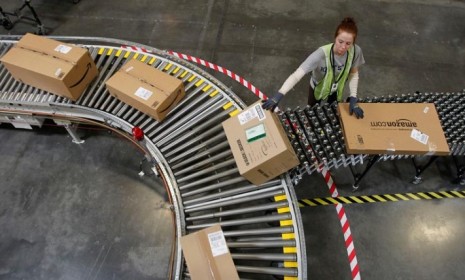How long can Amazon go without making money?
The online retailer posts a loss for the third quarter, but investors are utterly unfazed by the company's consistently poor earnings

This week, Amazon reported a loss of $274 million for the third quarter, its first loss since 2003. What's more, the online behemoth's revenues came in below analysts' expectations. But while such seriously grim news would have repercussions for any other company, Amazon's stocks faltered only momentarily before continuing a steady climb. Indeed, despite consistently poor earnings reports (while Amazon made $63 million in the third quarter of 2011, Apple profited by $7.3 billion in the same period), Amazon's stock is up nearly 30 percent this year. How does the company get away with it? "What separates Amazon from the competition is that it is not trying to make money," says David Streitfeld at The New York Times:
It is instead trying to grow as fast as it can, something it has been doing successfully for 15 years. What was once a cute start-up is now one of the country's biggest retailers.
Amazon sells products at a steep discount, and sometimes (as with its Kindle Fire line) even at a loss. While the strategy entails that Amazon makes little-to-no profit, it has the advantage of savagely undercutting competitors — like RadioShack and Best Buy — that are now in danger of going extinct. Investors love it, which means retailers of all stripes should be scared, says Matthew Yglesias at Slate:
The Week
Escape your echo chamber. Get the facts behind the news, plus analysis from multiple perspectives.

Sign up for The Week's Free Newsletters
From our morning news briefing to a weekly Good News Newsletter, get the best of The Week delivered directly to your inbox.
From our morning news briefing to a weekly Good News Newsletter, get the best of The Week delivered directly to your inbox.
In any line of business where you're earning healthy profits you always need to worry that a competitor will undercut you on price. But normally you can also have some confidence that they'll be restrained in their price cutting by the need to maintain profits of their own. Amazon is totally off the leash in this regard. Wall Street treats it like a brand new startup that just needs to think about growth and can find a viable business model later.
So how long can Amazon go without making money? For now, Wall Street is patiently waiting to reap the rewards of its numerous investments, say Greg Bensinger and John Letzing at The Wall Street Journal:
Despite persistently razor-thin margins and heavy spending, Amazon has maintained the faith of investors by promising greater profits down the road as its investments in new hand-held devices, fulfillment centers, cloud storage and other projects pay dividends.
A free daily email with the biggest news stories of the day – and the best features from TheWeek.com
-
 Farage’s £9m windfall: will it smooth his path to power?
Farage’s £9m windfall: will it smooth his path to power?In Depth The record donation has come amidst rumours of collaboration with the Conservatives and allegations of racism in Farage's school days
-
 The issue dividing Israel: ultra-Orthodox draft dodgers
The issue dividing Israel: ultra-Orthodox draft dodgersIn the Spotlight A new bill has solidified the community’s ‘draft evasion’ stance, with this issue becoming the country’s ‘greatest internal security threat’
-
 Codeword: December 13, 2025
Codeword: December 13, 2025The daily codeword puzzle from The Week